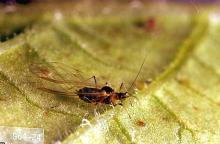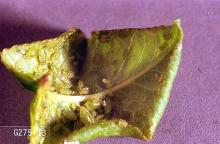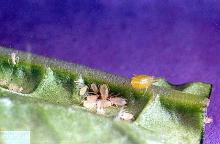Pest description and crop damage Aphids are small, soft-bodied insects with piercing-sucking mouthparts formed into a long needle-like stylet they hold under their body when not feeding. They are usually identified by host plant, and characters such as color, wing venation, antennae, and cornicles (two tubular structures on the hind section of the aphid). The same species can vary in color, shape, and size depending on the time of the year. Immature nymphs look like smaller versions of adult nymphs. Some aphid species produce waxy strands over their surface. All are soft-bodied insects with a piercing-sucking mouthpart called a stylet. Crop damage includes distorted plant growth, particularly terminals, deposition of a sweet, shiny liquid called honeydew, black sooty mold (which grows on the honeydew), waxy deposits (some species), yellowing, plant galls (on some hosts) and general plant decline. Several aphid species are also vectors of plant diseases, particularly viruses.
Biology and life history Most species of aphid have similar life cycles. Aphid females reproduce asexually through live birth most of the year. Aphid populations generally are most abundant during the cooler spring and fall seasons where populations can build up quickly. Aphids are usually found in colonies. In spring and fall, under crowded conditions, or when the nutritional quality of their host plant is reduced, aphids may produce winged adults (alates) which can disperse. In the fall, aphids mate and produce eggs for overwintering, especially in colder climates. Some species of adult aphid overwinter on crops, weeds, or trees. There may be as few as two generations or as many as 16 generations each year, depending on the species and climate. Most aphids are associated with one or several host plants. Some have alternate hosts, overwintering on one host and moving to another as the season progresses. Several species have a wide host range, with many host plants including weed species. Examples of these species include: green peach aphid (Myzus persicae), and cotton or melon aphid (Aphis gossipea). There are aphid species in the Pemphigidae, which are root aphids, that spend some of their life cycle on the root systems of their host plants such as conifers, poplars and ash.
Scouting and thresholds Monitor for aphids on at least weekly during the growing season. Scout for aphids near growing terminals near buds and fruit clusters, and leaf undersides, particularly alongside leaf veins. White cast skins, shiny honeydew, black sooty mold, and misshapen terminals are good indicators of aphid presence. Yellow sticky traps and yellow pan traps can help monitor flights of adults. Look for signs of natural enemy activity, including predators and parasites. The bodies of parasitized aphids, called mummies, will look slightly swollen brown or black, sometimes with an exit hole made by tiny wasps.
Management-biological control
See also:
Biological Control of Nursery Pests
Management-cultural control
A strong spray of water alone often effectively removes aphids. Control of associated ant species which move and protect aphids from their naturally enemies may provide additional control of the aphid populations. Aphid populations tend to be higher in plants that are fertilized liberally with nitrogen and heavily watered, as this produces flushes of succulent growth. Avoid excessive watering, and use slow-release forms or organic sources of nitrogen.
Management-chemical control
See also:
Chemical Control of Nursery Pests
There are a variety of chemical tactics available for these soft-bodied insects including relatively low toxicity contact products including soaps, oils, and botanicals. Good coverage with contact pesticides is essential. Also available are very selective chemical tools such as insect growth regulators and active ingredients with novel modes of actions such as pymetrozine (Endeavor) which disables the sucking mechanism of the aphids. Microbial pesticides such as those using the fungus Beauveria bassiani (Botanigard, Naturalis O) generally benefit from higher levels of humidity such as can be found during the spring and fall and in many protected systems. Systemic insecticides are particularly useful when contact is difficult and to protect new growth over time. Broad spectrum insecticides are generally less IPM compatible but may be useful when multiple types of insects must be treated.




